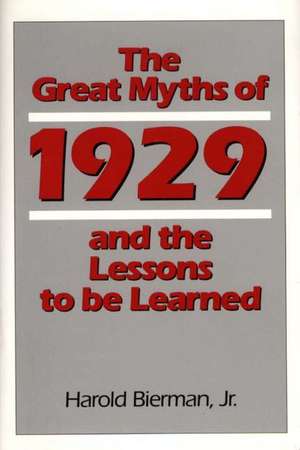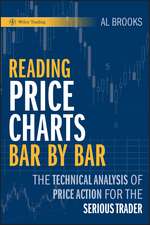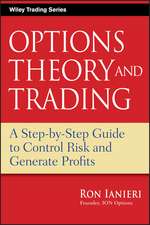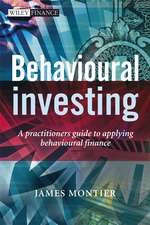The Great Myths of 1929 and the Lessons to Be Learned: Contributions in Economics and Economic History
Autor Harold Bierman Jr.en Limba Engleză Hardback – 29 mar 1991 – vârsta până la 17 ani
Din seria Contributions in Economics and Economic History
- 28%
 Preț: 437.07 lei
Preț: 437.07 lei - 27%
 Preț: 446.44 lei
Preț: 446.44 lei - 27%
 Preț: 441.64 lei
Preț: 441.64 lei - 24%
 Preț: 464.32 lei
Preț: 464.32 lei - 28%
 Preț: 344.98 lei
Preț: 344.98 lei - 28%
 Preț: 438.07 lei
Preț: 438.07 lei - 27%
 Preț: 438.41 lei
Preț: 438.41 lei - 27%
 Preț: 438.24 lei
Preț: 438.24 lei - 38%
 Preț: 345.67 lei
Preț: 345.67 lei - 38%
 Preț: 437.91 lei
Preț: 437.91 lei - 28%
 Preț: 437.40 lei
Preț: 437.40 lei - 28%
 Preț: 436.92 lei
Preț: 436.92 lei - 28%
 Preț: 437.24 lei
Preț: 437.24 lei - 18%
 Preț: 355.60 lei
Preț: 355.60 lei - 28%
 Preț: 437.47 lei
Preț: 437.47 lei - 38%
 Preț: 437.67 lei
Preț: 437.67 lei - 27%
 Preț: 438.76 lei
Preț: 438.76 lei - 38%
 Preț: 438.33 lei
Preț: 438.33 lei - 24%
 Preț: 464.05 lei
Preț: 464.05 lei - 27%
 Preț: 442.81 lei
Preț: 442.81 lei - 28%
 Preț: 437.47 lei
Preț: 437.47 lei - 24%
 Preț: 462.20 lei
Preț: 462.20 lei - 28%
 Preț: 437.84 lei
Preț: 437.84 lei - 27%
 Preț: 438.59 lei
Preț: 438.59 lei - 28%
 Preț: 434.78 lei
Preț: 434.78 lei - 38%
 Preț: 345.83 lei
Preț: 345.83 lei - 27%
 Preț: 438.51 lei
Preț: 438.51 lei - 28%
 Preț: 438.07 lei
Preț: 438.07 lei - 28%
 Preț: 437.40 lei
Preț: 437.40 lei - 27%
 Preț: 634.79 lei
Preț: 634.79 lei - 24%
 Preț: 363.98 lei
Preț: 363.98 lei - 28%
 Preț: 459.08 lei
Preț: 459.08 lei - 27%
 Preț: 345.67 lei
Preț: 345.67 lei - 28%
 Preț: 436.99 lei
Preț: 436.99 lei - 24%
 Preț: 463.30 lei
Preț: 463.30 lei - 24%
 Preț: 464.48 lei
Preț: 464.48 lei - 38%
 Preț: 443.73 lei
Preț: 443.73 lei - 38%
 Preț: 436.57 lei
Preț: 436.57 lei - 38%
 Preț: 441.29 lei
Preț: 441.29 lei - 27%
 Preț: 363.73 lei
Preț: 363.73 lei - 24%
 Preț: 462.45 lei
Preț: 462.45 lei - 38%
 Preț: 345.23 lei
Preț: 345.23 lei - 38%
 Preț: 437.07 lei
Preț: 437.07 lei - 38%
 Preț: 439.17 lei
Preț: 439.17 lei - 28%
 Preț: 344.82 lei
Preț: 344.82 lei - 28%
 Preț: 437.31 lei
Preț: 437.31 lei - 28%
 Preț: 437.07 lei
Preț: 437.07 lei - 28%
 Preț: 437.31 lei
Preț: 437.31 lei - 38%
 Preț: 439.85 lei
Preț: 439.85 lei
Preț: 435.55 lei
Preț vechi: 602.94 lei
-28% Nou
Puncte Express: 653
Preț estimativ în valută:
83.35€ • 90.51$ • 70.02£
83.35€ • 90.51$ • 70.02£
Carte tipărită la comandă
Livrare economică 22 aprilie-06 mai
Preluare comenzi: 021 569.72.76
Specificații
ISBN-13: 9780313273650
ISBN-10: 0313273650
Pagini: 208
Ilustrații: bibliography
Dimensiuni: 140 x 210 x 15 mm
Greutate: 0.4 kg
Editura: Bloomsbury Publishing
Colecția Praeger
Seria Contributions in Economics and Economic History
Locul publicării:New York, United States
ISBN-10: 0313273650
Pagini: 208
Ilustrații: bibliography
Dimensiuni: 140 x 210 x 15 mm
Greutate: 0.4 kg
Editura: Bloomsbury Publishing
Colecția Praeger
Seria Contributions in Economics and Economic History
Locul publicării:New York, United States
Notă biografică
HAROLD BIERMAN, JR. is the Nicholas H. Noyes Professor of Business Administration, Johnson Graduate School of Management, Cornell University. A prolific writer, he has published 19 books since 1959, among them: Managerial Accounting, An Introduction, Topics in Cost Accounting and Decisions, Strategic Financial Planning and The Capital Budgeting Decision (with Seymour Smidt).
Cuprins
IntroductionThe Great Myths of 1929Setting the StageDispelling the MythsRadio Corporation of AmericaThe Federal Reserve Bank of New York--Federal Reserve Board WarThe Ups and Downs of the 1929 Stock MarketThe Hearings of 1931Revelations Dispelling the MythsMargin Buying, Pools, Short Selling, and the 1929 CrashThe Crash of 1987The Lessons to Be LearnedBibliographyIndex

















